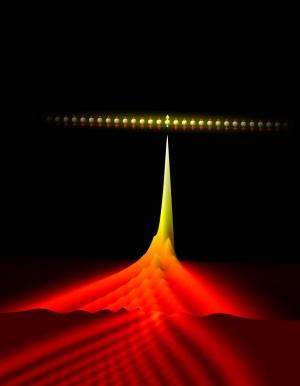New paths into the world of quasiparticles

Quasiparticles can be used to explain physical phenomena in solid bodies even though they are not actual physical particles. Physicists in Innsbruck have now realized quasiparticles in a quantum system and observed quantum mechanical entanglement propagation in a many-body system. The researchers have published their work in Nature.
Christian Roos' research team at the Institute for Quantum Optics and Quantum Information at the Austrian Academy of Sciences in Innsbruck has established a new experimental platform for investigating quantum phenomena: In a string of trapped ultracold ions they can precisely initialise, control and measure the states and properties of quasiparticle excitations in a many-body quantum system. "Quasiparticles are a well-established concept in physics to describe the collective behaviour of particles in a simplified way," says Christian Roos.
Entanglement propagation
For the experiment the physicists used a one-dimensional ion-string consisting of between seven and fifteen calcium ions trapped in a vacuum chamber. Laser beams then manipulate the quantum state of the ions. "Each particle behaves like a little quantum magnet interacting with each other," explains Petar Jurcevic, first author of this study. "The precise excitation of one of the particles also affects the other particles. The resulting collective behaviour of the system is called quasiparticles." These quasiparticles disperse to both sides of the excitation site on the ion-string, thereby, transporting quantum correlations. Excitation distribution has previously been observed in experiments with neutral atoms, where correlations between particles have also been shown. "In our experiments we have been able to determine that these correlations are quantum correlations," says Roos. "By measuring multi-particle correlations we have been able to detect and quantify quantum entanglement." The physicists were, thus, the first to show entanglement propagation in a quantum system.
In contrast to previous experiments, the researchers in Innsbruck can tune the ion-ion interaction range in the system from effectively nearest-neighbour to infinite range. In each case, a new set of quasiparticles is created with unique dynamical properties.
New research with quasiparticles
"With this new scheme we can precisely manipulate the quasiparticles," says an excited Philipp Hauke, one of the authors of this study. "It has taken us decades to come up with ways to precisely control and manipulate quantum particles. With this platform we can now do the same with quasiparticles and investigate phenomena that we haven't been able to study experimentally." For example, it opens up new paths to study how quantum systems reach equilibrium, including the question of when thermalisation occurs, a process that so far has remained elusive. "Another big goal is to utilize quasiparticles for quantum information processing," says Hauke. In addition, this platform could also be used to study the role of transport processes in biological systems. At the moment Christian Roos' research team is working on the idea to investigate interaction processes between two quasiparticles.
More information: Quasiparticle engineering and entanglement propagation in a quantum many-body system, DOI: 10.1038/nature13461
Journal information: Nature
Provided by University of Innsbruck





















